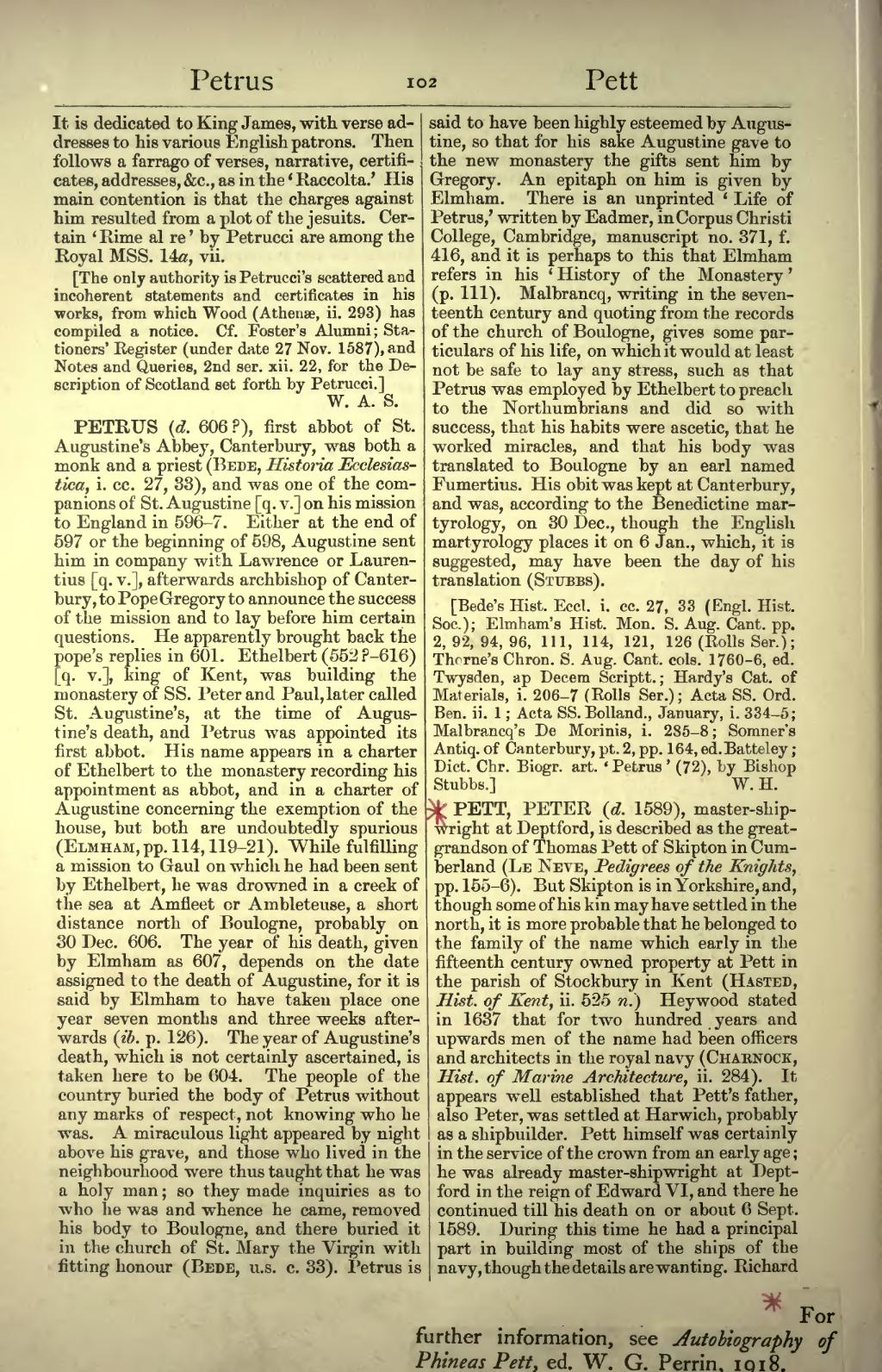It is dedicated to King James, with verse addresses to his various English patrons. Then follows a farrago of verses, narrative, certificates, addresses, &c., as in the ‘Raccolta.’ His main contention is that the charges against him resulted from a plot of the jesuits. Certain ‘Rime al re’ by Petrucci are among the Royal MSS. 14a, vii.
[The only authority is Petrucci's scattered and incoherent statements and certificates in his works, from which Wood (Athenæ, ii. 293) has compiled a notice. Cf. Foster's Alumni; Stationers' Register (under date 27 Nov. 1587), and Notes and Queries, 2nd ser. xii. 22, for the Description of Scotland set forth by Petrucci.]
PETRUS (d. 606?), first abbot of St. Augustine's Abbey, Canterbury, was both a monk and a priest (Bede, Historia Ecclesiastica, i. cc. 27, 33), and was one of the companions of St. Augustine [q. v.] on his mission to England in 596–7. Either at the end of 597 or the beginning of 598, Augustine sent him in company with Lawrence or Laurentius [q. v.], afterwards archbishop of Canterbury, to Pope Gregory to announce the success of the mission and to lay before him certain questions. He apparently brought back the pope's replies in 601. Ethelbert (552?–616) [q. v.], king of Kent, was building the monastery of SS. Peter and Paul, later called St. Augustine's, at the time of Augustine's death, and Petrus was appointed its first abbot. His name appears in a charter of Ethelbert to the monastery recording his appointment as abbot, and in a charter of Augustine concerning the exemption of the house, but both are undoubtedly spurious (Elmham, pp. 114, 119–21). While fulfilling a mission to Gaul on which he had been sent by Ethelbert, he was drowned in a creek of the sea at Amfleet or Ambleteuse, a short distance north of Boulogne, probably on 30 Dec. 606. The year of his death, given by Elmham as 607, depends on the date assigned to the death of Augustine, for it is said by Elmham to have taken place one year seven months and three weeks afterwards (ib. p. 126). The year of Augustine's death, which is not certainly ascertained, is taken here to be 604. The people of the country buried the body of Petrus without any marks of respect, not knowing who he was. A miraculous light appeared by night above his grave, and those who lived in the neighbourhood were thus taught that he was a holy man; so they made inquiries as to who he was and whence he came, removed his body to Boulogne, and there buried it in the church of St. Mary the Virgin with fitting honour (Bede, u.s. c. 33). Petrus is said to have been highly esteemed by Augustine, so that for his sake Augustine gave to the new monastery the gifts sent him by Gregory. An epitaph on him is given by Elmham. There is an unprinted ‘Life of Petrus,’ written by Eadmer, in Corpus Christi College, Cambridge, manuscript no. 371, f. 416, and it is perhaps to this that Elmham refers in his ‘History of the Monastery’ (p. 111). Malbrancq, writing in the seventeenth century and quoting from the records of the church of Boulogne, gives some particulars of his life, on which it would at least not be safe to lay any stress, such as that Petrus was employed by Ethelbert to preach to the Northumbrians and did so with success, that his habits were ascetic, that he worked miracles, and that his body was translated to Boulogne by an earl named Fumertius. His obit was kept at Canterbury, and was, according to the Benedictine martyrology, on 30 Dec., though the English martyrology places it on 6 Jan., which, it is suggested, may have been the day of his translation (Stubbs).
[Bede's Hist. Eccl. i. cc. 27, 33 (Engl. Hist. Soc.); Elmham's Hist. Mon. S. Aug. Cant. pp. 2, 92, 94, 96, 111, 114, 121, 126 (Rolls Ser.); Thorne's Chron. S. Aug. Cant. cols. 1760–6, ed. Twysden, ap Decem Scriptt.; Hardy's Cat. of Materials, i. 206–7 (Rolls Ser.); Acta SS. Ord. Ben. ii. 1; Acta SS. Bolland., January, i. 334–5; Malbrancq's De Morinis, i. 285–8; Somner's Antiq. of Canterbury, pt. 2, pp. 164, ed. Batteley; Dict. Chr. Biogr. art. ‘Petrus’ (72), by Bishop Stubbs.]
PETT, PETER (d. 1589), master-shipwright at Deptford, is described as the great-grandson of Thomas Pett of Skipton in Cumberland (Le Neve, Pedigrees of the Knights, pp. 155–6). But Skipton is in Yorkshire, and, though some of his kin may have settled in the north, it is more probable that he belonged to the family of the name which early in the fifteenth century owned property at Pett in the parish of Stockbury in Kent (Hasted, Hist. of Kent, ii. 525 n.) Heywood stated in 1637 that for two hundred years and upwards men of the name had been officers and architects in the royal navy (Charnock, Hist. of Marine Architecture, ii. 284). It appears well established that Pett's father, also Peter, was settled at Harwich, probably as a shipbuilder. Pett himself was certainly in the service of the crown from an early age; he was already master-shipwright at Deptford in the reign of Edward VI, and there he continued till his death on or about 6 Sept. 1589. During this time he had a principal part in building most of the ships of the navy, though the details are wanting. Richard
